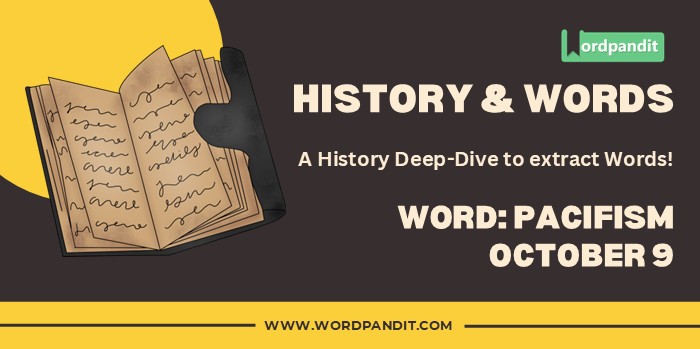History & Words: 'Pacifism' (October 9)
Welcome to 'History & Words.' 🌟 I'm Prashant, founder of Wordpandit and the Learning Inc. Network. This series combines my passion for language learning with historical context. Each entry explores a word's significance on a specific date, enhancing vocabulary while deepening understanding of history. Join me in this journey of words through time.
📚 Table of Contents
- Word of the Day
- Introduction
- Etymology
- Key Vocabulary
- Historical Context
- Timeline
- The Day's Significance
- Quote
- Modern Usage and Reflection
- Legacy
- Comparative Analysis
- Did You Know?
- Conclusion
- Further Reading
📚 Word of the Day: Pacifism
Pronunciation: /ˈpæsɪfɪzəm/ (PA-suh-fiz-uhm)
🌍 Introduction
On October 9, 1939, as the world teetered on the brink of what would become the deadliest conflict in human history, a powerful statement against war was unveiled in America. Pablo Picasso's monumental painting "Guernica" was exhibited for the first time in the United States, bringing its stark depiction of the horrors of war to a new audience. This event not only marked a significant moment in art history but also served as a poignant reminder of the ideals of pacifism in a time of escalating global conflict.
The term "pacifism," encapsulating the belief that war and violence are unjustifiable and that all disputes should be settled by peaceful means, found a visceral and haunting visual representation in Picasso's masterpiece. "Guernica," created in response to the bombing of the Basque town of the same name during the Spanish Civil War, became an enduring symbol of the devastating impact of war on innocent civilians and a rallying point for anti-war movements worldwide.
The exhibition of "Guernica" in America at this crucial historical juncture underscored the tension between pacifist ideals and the reality of a world plunging into war. It challenged viewers to confront the brutal consequences of conflict and to consider the moral imperative of peace, even as nations mobilized for battle. The painting's American debut thus serves as a powerful lens through which to explore the concept of pacifism and its place in a world often defined by violence and strife.
🌱 Etymology
The word "pacifism" has its roots in the Latin language, reflecting the ancient origins of the concept of peace. It is derived from the French word "pacifisme," which in turn comes from the Latin "pax," meaning "peace," and "-ficus," a suffix meaning "making" or "doing."
The Latin "pax" is found in many words related to peace, such as "pacific" (peaceful) and "pacify" (to bring peace). The "-ism" suffix, denoting a belief system or ideology, was added to create "pacifism," literally meaning "the ideology of making peace."
The term "pacifism" in its modern sense began to be widely used in the early 20th century, particularly in the context of growing anti-war movements in the lead-up to and during World War I.
📖 Key Vocabulary
- 🔑 Non-violence: The practice of abstaining from violence, often as a principle or strategy for social change.
- 🔑 Conscientious objection: The refusal to perform military service on moral or religious grounds.
- 🔑 Peace activism: Advocacy and action aimed at promoting peace and opposing war.
- 🔑 Diplomacy: The practice of conducting negotiations between representatives of states or groups.
- 🔑 Arbitration: The use of an arbitrator to settle a dispute, often as an alternative to war or litigation.
🏛️ Historical Context
The exhibition of Picasso's "Guernica" in America on October 9, 1939, occurred against a backdrop of escalating global conflict. Just over a month earlier, on September 1, Nazi Germany had invaded Poland, marking the beginning of World War II in Europe. The United States, while not yet officially involved in the war, was grappling with its role in the unfolding global crisis.
The interwar period had seen a surge in pacifist sentiment, particularly in the wake of the devastating losses of World War I. Organizations like the War Resisters' International, founded in 1921, promoted non-violent resistance to war. The Kellogg-Briand Pact of 1928, which attempted to outlaw war as an instrument of national policy, reflected this pacifist zeitgeist, even if it ultimately proved ineffective.
However, the rise of fascism in Europe during the 1930s posed a significant challenge to pacifist ideals. The Spanish Civil War (1936-1939), which inspired Picasso's "Guernica," became a battleground not just between Spanish factions but also between competing ideologies on a global scale. Many who had previously embraced pacifism found themselves grappling with the question of whether violence could be justified in the face of fascist aggression.
In the United States, isolationist sentiment remained strong in the late 1930s, with many Americans reluctant to become involved in another European war. However, the exhibition of "Guernica" coincided with growing awareness of the threat posed by Nazi Germany and increasing debate about America's role in the world.

⏳ Timeline
- 1901: Leo Tolstoy publishes "What Is War?", articulating a Christian pacifist philosophy
- 1914-1918: World War I leads to increased interest in pacifism
- 1919: Formation of the Fellowship of Reconciliation, a prominent pacifist organization
- 1921: Founding of War Resisters' International
- 1928: Signing of the Kellogg-Briand Pact, attempting to outlaw war
- April 26, 1937: Bombing of Guernica during the Spanish Civil War
- May-June 1937: Picasso paints "Guernica"
- July 1937: "Guernica" first exhibited at the Paris International Exposition
- October 9, 1939: "Guernica" exhibited for the first time in America
- 1940-1945: World War II challenges pacifist movements but also inspires new forms of non-violent resistance
- 1949: Albert Einstein publishes "Why War?", advocating for world peace
- 1960s-1970s: Anti-Vietnam War movement revitalizes pacifism in the US
🌟 The Day's Significance
October 9, 1939, marks a significant moment in the intersection of art, politics, and pacifist ideology. The exhibition of Pablo Picasso's "Guernica" in America on this day brought the stark realities of war to a new audience at a crucial historical juncture.
The significance of this event lies not just in its artistic importance but in its timing and context. As Europe was engulfed in the early stages of World War II, "Guernica" served as a powerful reminder of the human cost of conflict. Its American debut challenged viewers to confront the brutality of modern warfare and to consider the moral implications of violence on a massive scale.
"Guernica" had already gained international recognition since its creation in 1937 in response to the bombing of the Basque town during the Spanish Civil War. Its exhibition in America expanded its influence, making it a focal point for discussions about war, peace, and the role of art in society.
The painting's impact was profound. Its fragmented, agonized figures and stark black, white, and gray palette conveyed the chaos and suffering of war with unprecedented power. For many viewers, "Guernica" made the abstract concept of pacifism viscerally real, forcing a confrontation with the consequences of violence.
Moreover, the exhibition of "Guernica" in America served as a form of cultural diplomacy. It brought European anti-fascist sentiment to American shores, potentially influencing public opinion about the conflict unfolding across the Atlantic. The painting became a rallying point for those opposed to war and a powerful tool for peace activists.
💬 Quote
"Painting is not done to decorate apartments. It is an instrument of war." - Pablo Picasso
🔮 Modern Usage and Reflection
Today, pacifism remains a relevant and often contentious concept in discussions of foreign policy, conflict resolution, and social justice. While absolute pacifism – the rejection of all forms of violence under any circumstances – is relatively rare, many individuals and organizations advocate for non-violent approaches to conflict resolution and social change.
The principles of pacifism have influenced various movements and strategies, from Mahatma Gandhi's non-violent resistance in India to Martin Luther King Jr.'s civil rights activism in the United States. In international relations, pacifist ideals have contributed to the development of institutions like the United Nations and to efforts at disarmament and peacekeeping.
However, pacifism also continues to face challenges and criticisms, particularly in the context of responses to aggression or human rights abuses. Debates persist about the efficacy and morality of non-violent resistance in the face of violent oppression.
🏛️ Legacy
The legacy of pacifism, as embodied in works like "Guernica" and in the actions of pacifist individuals and organizations throughout history, is complex and far-reaching. Pacifist ideas have contributed to the development of international law, human rights frameworks, and conflict resolution techniques.
The influence of pacifism can be seen in the growth of peace studies as an academic discipline, in the establishment of institutions dedicated to conflict prevention and resolution, and in the continued efforts of peace activists worldwide.
Moreover, the pacifist emphasis on non-violent methods of protest and social change has shaped modern civil society movements, from environmental activism to campaigns for social and economic justice.
🔍 Comparative Analysis
When "Guernica" was first exhibited in America in 1939, pacifism was often viewed as an idealistic, even naive philosophy in the face of fascist aggression. The painting's stark depiction of the horrors of war, however, gave pacifist arguments a powerful emotional resonance.
Today, while the basic tenets of pacifism remain the same, the context in which it operates has changed dramatically. The nature of warfare has evolved, with cyber conflicts and terrorism presenting new challenges to traditional pacifist approaches. Additionally, the interconnectedness of the global economy has made non-violent methods like economic sanctions more potent tools for conflict resolution.
The evolution of pacifism reflects broader changes in how we understand conflict and peace. There's growing recognition of the importance of addressing root causes of violence, such as poverty and inequality, alongside efforts to prevent or resolve armed conflicts.
💡 Did You Know?
🎓 Conclusion
The exhibition of "Guernica" in America on October 9, 1939, stands as a powerful moment in the history of pacifism and anti-war art. It reminds us of the enduring relevance of pacifist ideals in a world still grappling with conflict and violence. As we reflect on this historic event, we are challenged to consider the role of art in shaping public opinion, the power of non-violent resistance, and the ongoing struggle to build a more peaceful world. The legacy of "Guernica" and the pacifist movement it symbolizes continues to inspire and provoke, urging us to confront the realities of war and to strive for peaceful resolutions to conflict.
📚 Further Reading
- 📘 "Pacifism: A Philosophy of Non-Violence" by Robert L. Holmes
- 📗 "Guernica: The Biography of a Twentieth-Century Icon" by Gijs van Hensbergen
- 📙 "The Power of Non-Violence" by Richard B. Gregg












